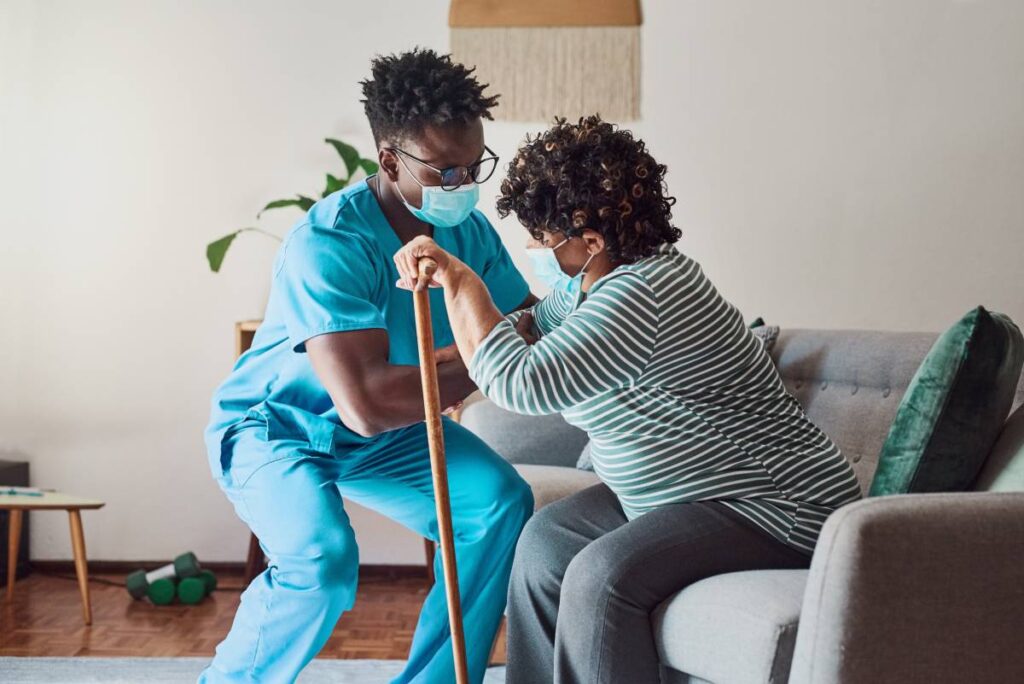Since the emergence of the SARS-CoV-2 virus in China in 2019, the COVID-19 pandemic has infected nearly 500 million people around the world, resulting in 6 million deaths (1). Despite the common respiratory symptoms of the viral infection, COVID-19 affects all organ systems of the body, from the gastrointestinal tract to the brain to the eyes (2). In addition to exhibiting high transmissibility, the infection causes severe morbidity and mortality, with a case fatality rate at least five times higher than influenza (3). At the beginning of the pandemic, tens of thousands of Americans were admitted to hospitals with severe COVID-19, where around 28% were transferred to the intensive care unit (ICU) and 13% died (4). Although the majority of the surviving patients exited the hospital within six to fifteen days after admission, many of them continued to suffer from symptoms months later (3). Coined “long COVID” by the media and “post-acute sequelae of COVID-19 (PASC)” by the scientific community, the chronic persistence of symptoms affects 10-35% of patients who sustained COVID mild or moderate severity, as well as at least 75% of patients who had severe illness (5, 6).
PASC entails physical, cognitive, and psychological symptoms that persist or emerge at least 4 weeks after recovery from acute COVID-19 infection (5, 6). Despite the fact that “long haulers” typically test negative for the virus, they continue to report symptoms, most commonly fatigue, dyspnea, and chest pain (5). The severity of PASC is associated with the severity of the initial infection — therefore, patients with severe cases are significantly more likely to experience PASC and suffer more symptoms (7).
One cohort study found that 74% of severe COVID-19 patients admitted to the ICU still presented at least one symptom a year later (6). Physical symptoms, most commonly weakened condition, joint pain, muscle weakness, fatigue, and myalgia, were reported by 74% of these patients; mental symptoms, including depression, anxiety, and post-traumatic stress disorder, were reported by 26%; and cognitive symptoms, such as confusion or “brain fog,” were reported by 25% (6). Researchers believe that long-term hospital care itself may cause or contribute to many of these symptoms, as approximately 25% of patients admitted to the ICU for any reason report similar physical and cognitive symptoms one year later, which could be linked to inactivity, mechanical ventilation, and other features of hospital stays (8). However, given the prevalence, longevity, and unique syndrome of PASC, most researchers believe the condition arises from the nature of the virus itself — while the exact cause of PASC remains unknown, some researchers theorize that the SARS-CoV-2 virus causes long-term damage to the organs, impedes nerve signaling, damages autoimmunity, and overexcites the immune system, leading to long-term symptoms in some people but not all (9).
As vaccination rates rise, cases decline, and thousands of “long haulers” continue posting their experiences on social media, researchers are beginning to shift their focus from acute COVID-19 etiology to the long-term consequences of the infection. Although there is no cure, researchers recommend working with PASC patients to treat their individual symptoms and rule out other potential conditions (5, 10). Additionally, researchers urge individuals to seek vaccination to reduce the risk of contracting severe COVID-19 and therefore suffering PASC (11).
References
1: Johns Hopkins University Center for Systems Science and Engineering (2022). COVID-19 dashboard. URL: https://www.arcgis.com/apps/dashboards/bda7594740fd40299423467b48e9ecf6.
2: Jain, U. (2020). Effect of COVID-19 on the organs. Cureus, vol. 12(8). DOI: 10.7759/cureus.9540.
3: Faust, J. and del Rio, C. (2020). Assessment of deaths from COVID-19 and from seasonal influenza. JAMA Internal Medicine, vol. 180(8). DOI: 10.1001/jamainternmed.2020.2306.
4: Nguyen, N., Chinn, J., Nahmias, J., Yuen, S., Kirby, K., Hohmann, S. and Amin, A. (2021). Outcomes and mortality among adults hospitalized with COVID-19 at US medical centers. JAMA Network Open, vol. 4(3). DOI: 10.1001/jamanetworkopen.2021.0417.
5: Pavli, A., Theodoridou, M. and Maltezou, H. (2021). Post-COVID syndrome: incidence, clinical spectrum, and challenges for primary healthcare professionals. Archives of Medical Research, vol. 52(6). DOI: 10.1016/j.arcmed.2021.03.010.
6: Heesakkers, H., van der Hoeven, J., Corsten, S., Janssen, I., Ewalds, E., Simons, K., Westerhof, B., Rettig, T., Jacobs, C., van Santen, S., Slooter, A., van der Woude, M., van den Boogaard, M. and Zegers, M. (2022). Clinical outcomes among patients with 1-year survival following intensive care unit treatment for COVID-19. JAMA, vol. 327(6). DOI: 10.1001/jama.2022.0040.
7: Xie, Y., Bowe, B. and Al-Aly, Z. (2021). Burdens of post-acute sequelae of COVID-19 by severity of acute infection, demographics and health status. Nature Communications, vol. 12. DOI: 10.1038/s41467-021-26513-3.
8: Rawal, G., Yadav, S. and Kumar, R. (2017). Post-intensive care syndrome: an overview. Journal of Translational Internal Medicine, vol. 5(2). DOI: 10.1515/jtim-2016-0016.
9: Proal, A. and van Elzakker, M. (2021). Long COVID or post-acute sequelae of COVID-19 (PASC): an overview of biological factors that may contribute to persistent symptoms. Frontiers in Microbiology, vol. 12. DOI: 10.3389/fmicb.2021.698169.
10: Cha, C. and Baek, G. (2021). Symptoms and management of long COVID: a scoping review. Journal of Clinical Nursing, 2021(00). DOI: 10.1111/jocn.16150.
11: Groff, D., Sun, A., Ssentongo, A., Ba, D., Parsons, N., Poudel, G., Lekoubou, A., Oh, S., Ericson, J., Ssentongo, P. and Chinchilli, V. (2021). Short-term and long-term rates of post-acute sequelae of SARS-CoV-2 infection. JAMA Network Open, vol. 4(10). DOI: 10.1001/jamanetworkopen.2021.28568.
